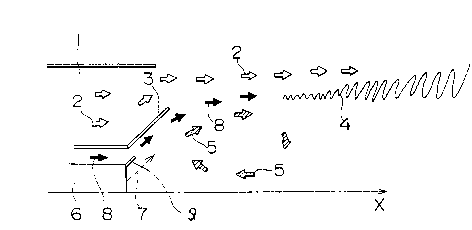Une partie des informations de ce site Web a été fournie par des sources externes. Le gouvernement du Canada n'assume aucune responsabilité concernant la précision, l'actualité ou la fiabilité des informations fournies par les sources externes. Les utilisateurs qui désirent employer cette information devraient consulter directement la source des informations. Le contenu fourni par les sources externes n'est pas assujetti aux exigences sur les langues officielles, la protection des renseignements personnels et l'accessibilité.
L'apparition de différences dans le texte et l'image des Revendications et de l'Abrégé dépend du moment auquel le document est publié. Les textes des Revendications et de l'Abrégé sont affichés :
| (12) Brevet: | (11) CA 2134893 |
|---|---|
| (54) Titre français: | METHODE ET CHAMBRE DE COMBUSTION POUR LA COMBUSTION D'UN PREMELANGE DE GAZ |
| (54) Titre anglais: | METHOD AND COMBUSTOR FOR THE COMBUSTION OF A PREMIXED GAS |
| Statut: | Périmé et au-delà du délai pour l’annulation |
| (51) Classification internationale des brevets (CIB): |
|
|---|---|
| (72) Inventeurs : |
|
| (73) Titulaires : |
|
| (71) Demandeurs : |
|
| (74) Agent: | GOWLING WLG (CANADA) LLP |
| (74) Co-agent: | |
| (45) Délivré: | 1999-09-07 |
| (86) Date de dépôt PCT: | 1994-03-08 |
| (87) Mise à la disponibilité du public: | 1994-09-15 |
| Requête d'examen: | 1994-11-01 |
| Licence disponible: | S.O. |
| Cédé au domaine public: | S.O. |
| (25) Langue des documents déposés: | Anglais |
| Traité de coopération en matière de brevets (PCT): | Oui |
|---|---|
| (86) Numéro de la demande PCT: | PCT/JP1994/000363 |
| (87) Numéro de publication internationale PCT: | JP1994000363 |
| (85) Entrée nationale: | 1994-11-01 |
| (30) Données de priorité de la demande: | ||||||
|---|---|---|---|---|---|---|
|
An object of the present invention is to overcome the
disadvantages of a conventional combustor having a fuel-air
premixing nozzle wherein variation in combustion rate
resulting from variation in the fuel concentration of the
premixed gas cause variation in flame length and may
eventually lead to the development of combustive vibration.
This invention provides a combustion method and combustor
which is characterized in that a fluid (8) containing no
fuel is fed between a premixed gas layer (2) formed by
injecting a premixed gas through a premixing nozzle (1) and
a hot gas layer (5) formed from a portion of the hot gas
resulting from the combustion of the premixed gas, the hot
gas layer (5) circulating or staying in a region downstream
of the outlet of the premixing nozzle (1).
Note : Les revendications sont présentées dans la langue officielle dans laquelle elles ont été soumises.
Note : Les descriptions sont présentées dans la langue officielle dans laquelle elles ont été soumises.

2024-08-01 : Dans le cadre de la transition vers les Brevets de nouvelle génération (BNG), la base de données sur les brevets canadiens (BDBC) contient désormais un Historique d'événement plus détaillé, qui reproduit le Journal des événements de notre nouvelle solution interne.
Veuillez noter que les événements débutant par « Inactive : » se réfèrent à des événements qui ne sont plus utilisés dans notre nouvelle solution interne.
Pour une meilleure compréhension de l'état de la demande ou brevet qui figure sur cette page, la rubrique Mise en garde , et les descriptions de Brevet , Historique d'événement , Taxes périodiques et Historique des paiements devraient être consultées.
| Description | Date |
|---|---|
| Inactive : CIB de MCD | 2006-03-11 |
| Inactive : CIB de MCD | 2006-03-11 |
| Inactive : CIB de MCD | 2006-03-11 |
| Le délai pour l'annulation est expiré | 2004-03-08 |
| Lettre envoyée | 2003-03-10 |
| Accordé par délivrance | 1999-09-07 |
| Inactive : Page couverture publiée | 1999-09-06 |
| Inactive : Taxe finale reçue | 1999-06-02 |
| Préoctroi | 1999-06-02 |
| Un avis d'acceptation est envoyé | 1999-03-22 |
| Lettre envoyée | 1999-03-22 |
| Un avis d'acceptation est envoyé | 1999-03-22 |
| Inactive : Renseign. sur l'état - Complets dès date d'ent. journ. | 1999-03-16 |
| Inactive : Dem. traitée sur TS dès date d'ent. journal | 1999-03-16 |
| Inactive : Approuvée aux fins d'acceptation (AFA) | 1999-02-19 |
| Toutes les exigences pour l'examen - jugée conforme | 1994-11-01 |
| Exigences pour une requête d'examen - jugée conforme | 1994-11-01 |
| Demande publiée (accessible au public) | 1994-09-15 |
Il n'y a pas d'historique d'abandonnement
Le dernier paiement a été reçu le 1999-02-03
Avis : Si le paiement en totalité n'a pas été reçu au plus tard à la date indiquée, une taxe supplémentaire peut être imposée, soit une des taxes suivantes :
Les taxes sur les brevets sont ajustées au 1er janvier de chaque année. Les montants ci-dessus sont les montants actuels s'ils sont reçus au plus tard le 31 décembre de l'année en cours.
Veuillez vous référer à la page web des
taxes sur les brevets
de l'OPIC pour voir tous les montants actuels des taxes.
| Type de taxes | Anniversaire | Échéance | Date payée |
|---|---|---|---|
| TM (demande, 4e anniv.) - générale | 04 | 1998-03-09 | 1998-01-27 |
| TM (demande, 5e anniv.) - générale | 05 | 1999-03-08 | 1999-02-03 |
| Taxe finale - générale | 1999-06-02 | ||
| TM (brevet, 6e anniv.) - générale | 2000-03-08 | 2000-02-07 | |
| TM (brevet, 7e anniv.) - générale | 2001-03-08 | 2001-02-19 | |
| TM (brevet, 8e anniv.) - générale | 2002-03-08 | 2002-02-18 |
Les titulaires actuels et antérieures au dossier sont affichés en ordre alphabétique.
| Titulaires actuels au dossier |
|---|
| MITSUBISHI JUKOGYO KABUSHIKI KAISHA |
| Titulaires antérieures au dossier |
|---|
| KATSUNORI TANAKA |
| NOBUO SATO |
| SATOSHI TANIMURA |
| SHIGEMI MANDAI |